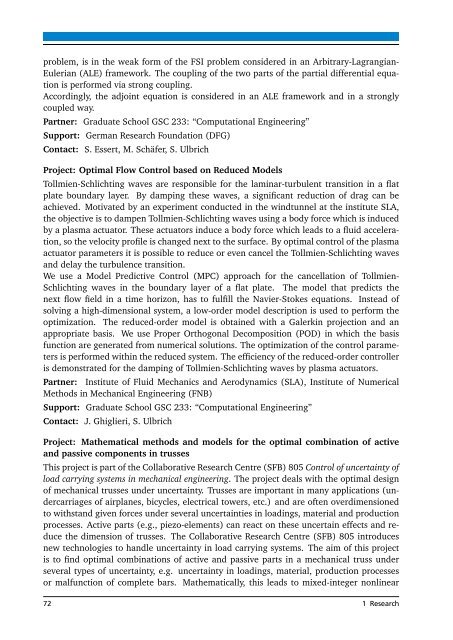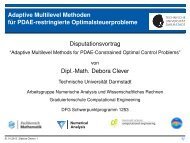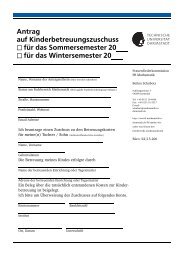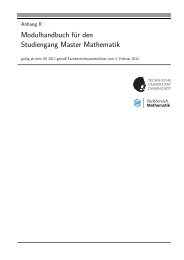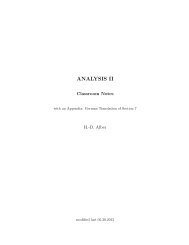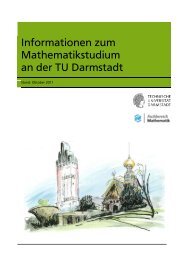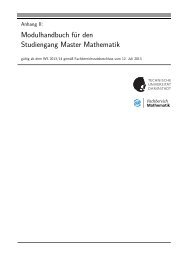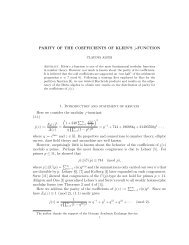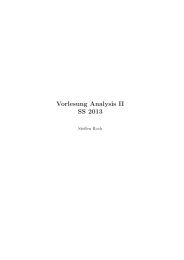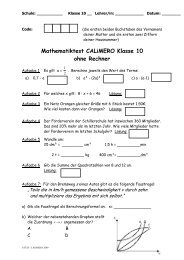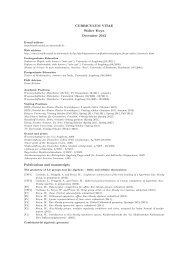Biannual Report - Fachbereich Mathematik - Technische Universität ...
Biannual Report - Fachbereich Mathematik - Technische Universität ...
Biannual Report - Fachbereich Mathematik - Technische Universität ...
You also want an ePaper? Increase the reach of your titles
YUMPU automatically turns print PDFs into web optimized ePapers that Google loves.
problem, is in the weak form of the FSI problem considered in an Arbitrary-Lagrangian-<br />
Eulerian (ALE) framework. The coupling of the two parts of the partial differential equation<br />
is performed via strong coupling.<br />
Accordingly, the adjoint equation is considered in an ALE framework and in a strongly<br />
coupled way.<br />
Partner: Graduate School GSC 233: “Computational Engineering”<br />
Support: German Research Foundation (DFG)<br />
Contact: S. Essert, M. Schäfer, S. Ulbrich<br />
Project: Optimal Flow Control based on Reduced Models<br />
Tollmien-Schlichting waves are responsible for the laminar-turbulent transition in a flat<br />
plate boundary layer. By damping these waves, a significant reduction of drag can be<br />
achieved. Motivated by an experiment conducted in the windtunnel at the institute SLA,<br />
the objective is to dampen Tollmien-Schlichting waves using a body force which is induced<br />
by a plasma actuator. These actuators induce a body force which leads to a fluid acceleration,<br />
so the velocity profile is changed next to the surface. By optimal control of the plasma<br />
actuator parameters it is possible to reduce or even cancel the Tollmien-Schlichting waves<br />
and delay the turbulence transition.<br />
We use a Model Predictive Control (MPC) approach for the cancellation of Tollmien-<br />
Schlichting waves in the boundary layer of a flat plate. The model that predicts the<br />
next flow field in a time horizon, has to fulfill the Navier-Stokes equations. Instead of<br />
solving a high-dimensional system, a low-order model description is used to perform the<br />
optimization. The reduced-order model is obtained with a Galerkin projection and an<br />
appropriate basis. We use Proper Orthogonal Decomposition (POD) in which the basis<br />
function are generated from numerical solutions. The optimization of the control parameters<br />
is performed within the reduced system. The efficiency of the reduced-order controller<br />
is demonstrated for the damping of Tollmien-Schlichting waves by plasma actuators.<br />
Partner: Institute of Fluid Mechanics and Aerodynamics (SLA), Institute of Numerical<br />
Methods in Mechanical Engineering (FNB)<br />
Support: Graduate School GSC 233: “Computational Engineering”<br />
Contact: J. Ghiglieri, S. Ulbrich<br />
Project: Mathematical methods and models for the optimal combination of active<br />
and passive components in trusses<br />
This project is part of the Collaborative Research Centre (SFB) 805 Control of uncertainty of<br />
load carrying systems in mechanical engineering. The project deals with the optimal design<br />
of mechanical trusses under uncertainty. Trusses are important in many applications (undercarriages<br />
of airplanes, bicycles, electrical towers, etc.) and are often overdimensioned<br />
to withstand given forces under several uncertainties in loadings, material and production<br />
processes. Active parts (e.g., piezo-elements) can react on these uncertain effects and reduce<br />
the dimension of trusses. The Collaborative Research Centre (SFB) 805 introduces<br />
new technologies to handle uncertainty in load carrying systems. The aim of this project<br />
is to find optimal combinations of active and passive parts in a mechanical truss under<br />
several types of uncertainty, e.g. uncertainty in loadings, material, production processes<br />
or malfunction of complete bars. Mathematically, this leads to mixed-integer nonlinear<br />
72 1 Research


